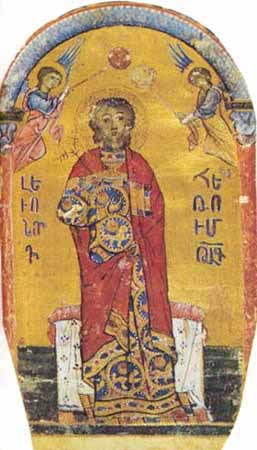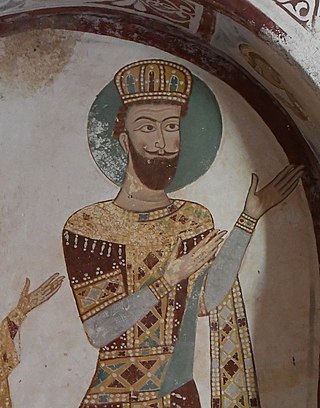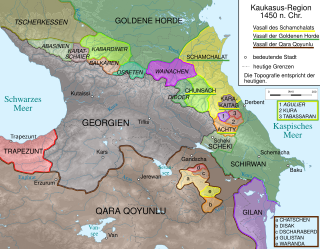
Constantine XI Dragases Palaiologos or DragašPalaeologus was the last Byzantine emperor, reigning from 1449 until his death in battle at the Fall of Constantinople in 1453. Constantine's death marked the definitive end of the Eastern Roman Empire, which traced its origin to Constantine the Great's foundation of Constantinople as the Roman Empire's new capital in 330.

Romanos I Lakapenos or Lekapenos or the Gentle Usurper, Latinized as Romanus I Lecapenus, was Byzantine emperor from 920 until his deposition in 944, serving as regent for and senior co-ruler of the young Constantine VII.

Romanos IV Diogenes was Byzantine emperor from 1068 to 1071. Determined to halt the decline of the Byzantine military and to stop Turkish incursions into the empire, he is nevertheless best known for his defeat and capture in 1071 at the Battle of Manzikert, which played a major role in undermining Byzantine authority in Anatolia and allowed for its gradual Turkification.

The Battle of Manzikert or Malazgirt was fought between the Byzantine Empire and the Seljuk Empire on 26 August 1071 near Manzikert, Iberia. The decisive defeat of the Byzantine army and the capture of the emperor Romanos IV Diogenes played an important role in undermining Byzantine authority in Anatolia and Armenia, and allowed for the gradual Turkification of Anatolia. Many Turks, travelling westward during the 11th century, saw the victory at Manzikert as an entrance to Asia Minor.

Constantine X Doukas or Ducas, was Byzantine emperor from 1059 to 1067. He was the founder of the Doukid dynasty. During his reign, the Normans took over much of the remaining Byzantine territories in Italy, while in the Balkans the Hungarians occupied Belgrade. He also suffered defeats by the Seljuk sultan Alp Arslan.

Constantine III was the King of Armenian Cilicia from 1344 to 1362. He was the son of Baldwin, Lord of Neghir, and second cousin of Constantine II.

Constantine IV was the King of Armenian Cilicia from 1362 until his death. He was the son of Hethum of Neghir, a nephew of Hethum I of Armenia. Constantine came to the throne on the death of his cousin Constantine III, whose widow, Maria, daughter of Oshin of Corycos, he married.

Leo IV or Leon IV was the last Hethumid king of Cilicia, ruling from 1320 until his death. He was the son of Oshin of Armenia and Isabel of Korikos, and came to the throne on the death of his father. His name is sometimes spelled as Leo or Leon.

Hethum I ruled the Armenian Kingdom of Cilicia from 1226 to 1270. He was the son of Constantine of Baberon and Princess Alix Pahlavouni of Lampron and was the founder of the dynasty which bears his name: the Hethumids also known as the House of Lampron. Having accepted the suzerainty of the Mongol Empire, Hethum himself traveled to the Mongol court in Karakorum, Mongolia, a famous account of which is given by Hethum's companion, the historian Kirakos Gandzaketsi, in his History of Armenia. He allied with the Mongols to fight against the Muslim Mamluks and also encouraged other Crusader states to do the same.

Leo II or Leon II was king of the Armenian Kingdom of Cilicia, ruling from 1269/1270 to 1289. He was the son of King Hetoum I and Queen Isabella and was a member of the House of Lampron.

The Armenian Kingdom of Cilicia, also known as Cilician Armenia, Lesser Armenia, Little Armenia or New Armenia, and formerly known as the Armenian Principality of Cilicia, was an Armenian state formed during the High Middle Ages by Armenian refugees fleeing the Seljuk invasion of Armenia. Located outside the Armenian Highlands and distinct from the Kingdom of Armenia of antiquity, it was centered in the Cilicia region northwest of the Gulf of Alexandretta.

The House of Lusignan was a royal house of French origin, which at various times ruled several principalities in Europe and the Levant, including the kingdoms of Jerusalem, Cyprus, and Armenia, from the 12th through the 15th centuries during the Middle Ages. It also had great influence in England and France.

Alexander II was a king (mepe) of Georgia in 1478 and of Imereti from 1483 to 1510.
Alice of Armenia was ruling Lady of Toron from 1229 to 1234 as the eldest daughter of Ruben III, Prince of Armenia and his wife Isabella of Toron. She was heiress of Toron as well as a claimant to the throne of Armenia. She married three times; by her second marriage she was Countess of Tripoli, and she only had children from this marriage.
Callinicus IV, born Constantine Mavrikios was Ecumenical Patriarch of Constantinople for a few months in 1757 and a writer and scholar.
Gurandukht was a daughter of King George I of Georgia by his first wife Mariam. She was active in the politics of Georgia during the reign of her brother Bagrat IV.

The Samtskhe-Saatabago or Samtskhe Atabegate, also called the Principality of Samtskhe, was a Georgian feudal principality in Zemo Kartli, ruled by an atabeg (tutor) of Georgia for nearly three and a half centuries, between 1268 and 1625. Its territory consisted of the modern-day Samtskhe-Javakheti region and the historical region of Tao-Klarjeti.

The Kingdom of Kartli was a late medieval and early modern monarchy in eastern Georgia, centred on the province of Kartli, with its capital at Tbilisi. It emerged in the process of a tripartite division of the Kingdom of Georgia in 1478 and existed, with several brief intervals, until 1762 when Kartli and the neighbouring Georgian kingdom of Kakheti were merged through dynastic succession under the Kakhetian branch of the Bagrationi dynasty. Through much of this period, the kingdom was a vassal of the successive dynasties of Iran, and to a much shorter period Ottoman Empire, but enjoyed intermittent periods of greater independence, especially after 1747.

The Turkoman invasions of Georgia also Georgian–Turkoman wars, refers to invasions of various Muslim Turkoman tribes on the territory of the Kingdom of Georgia throughout the 15th century.

Byzantine Anatolia refers to the peninsula of Anatolia during the rule of the Byzantine Empire. Anatolia was of vital importance to the empire following the Muslim invasion of Syria and Egypt during the reign of the Byzantine Emperor Heraclius in the years 634–645 AD. Over the next two hundred and fifty years, the region suffered constant raids by Arab Muslim forces raiding mainly from the cities of Antioch, Tarsus, and Aleppo near the Anatolian borders. However, the Byzantine Empire maintained control over the Anatolian peninsula until the High Middle Ages, when imperial authority in the area began to collapse.
















